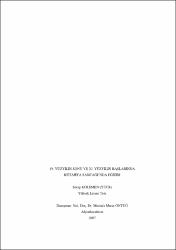19. Yüzyılın Sonu ve 20. Yüzyılın Başlarında Kütahya Sancağı’nda Eğitim
Özet
Çalışmada Osmanlı Devleti’ne tâbi Hüdâvendigâr Vilayeti’nin bir sancağı olan Kütahya Sancağı’nda 19. yüzyılın sonu ve 20. yüzyılın başlarında eğitimin dağılımı incelenmiştir. 1898-1904 yılları arası yayınlanan Maarif Salnameleri çalışmanın temel kaynağını teşkil etmektedir. Kütahya Sancağı ve kazalarındaki okullar, öğrenci sayıları, öğretmen kadroları, medreseler, gayrimüslimlere ve yabancılara ait okullar ile yaygın eğitim kurumu olan kütüphaneler salnamelerdeki bilgiler doğrultusunda tasnif edilmiştir.
Çalışma beş ana bölümden oluşmaktadır. Birinci bölümde; Kütahya Sancağı’ndaki sıbyan ve ibtidai mektepleri tanıtılmıştır. Çalışmanın ikinci bölümünü Kütahya Sancağı’ndaki geleneksel eğitim kurumu olarak faaliyet gösteren medreseler oluşturmaktadır. Üçüncü bölümde; Osmanlı Devleti’nde batılılaşmanın etkisiyle açılan okullar olan rüşdiyeler ve idadiler tanıtılmıştır. Dördüncü bölümde gayrimüslimler ve yabancılar tarafından kurulan okullar incelenmiştir. Çalışmanın beşinci ve son bölümünde Kütahya Sancağı’ndaki kütüphaneler tanıtılmıştır. Bunlardan “Vahit Paşa Kütüphanesi” günümüzde de hizmet vermektedir. In this study in the sanjak of Kütahya which was one of the sanjak of the province of Hüdâvendigâr related the Ottoman Empire, the dispersion of the education has been studied at the end of nineteenth century and at the beginning of twentieth century. “Maarif Salnameleri”, which were published between the years of 1898 and 1904, constitues the basic source of the study. The schools in the sanjak of Kütahya and its towns, the numbers of students, the staff of teachers, “Medreseler”, the schools which belong to non-muslims and foreigners and the libraries which are the instution of widespread education have been classified in the direction of the informations in “Salname”.
The study is composed of five basic sections. In the first section; “Sıbyan and İbtidai” schools which are in the sanjak of Kütahya have been introduced. The second section of the study constitutes the “Medreseler” which worked as the instution of traditional education. In the third section the schools in the Ottoman Empire which werw opened with the influence of the western “Rüşdiyeler and İdadiler” have been introduced. In the fourth section; the scools which were founded by foreigners and non¬muslims have been studied. In the fifth and last section, the libraries in the sanjak of Kütahya have been introduced. From these the library of “Vahit Paşa” still serves today.
Bağlantı
http://hdl.handle.net/11630/3369Koleksiyonlar
- Yüksek Lisans Tezleri [2074]



















